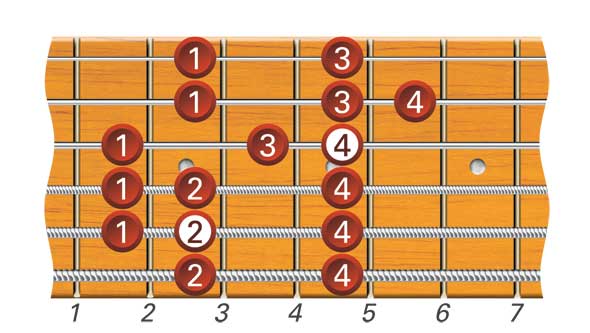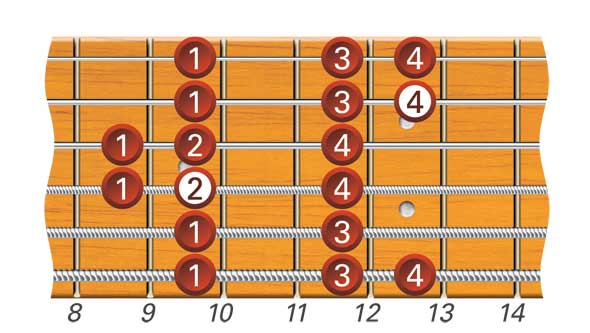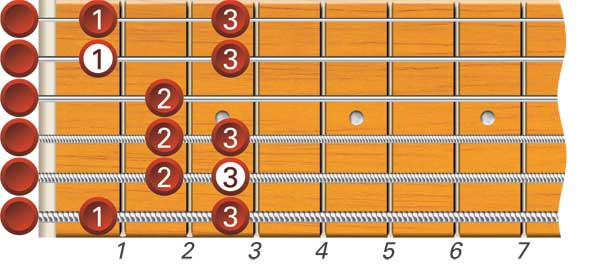
Movable Fingerings
For each mode there are five basic movable fingering patterns which can be moved to any part of the fretboard. These fingerings can be named according to the chord shape to which each fingering corresponds. The names of the five forms (formations or patterns) are easy to memorize because they spell the word CAGED when put together.
It is the position of the keynotes in each fingering which determines the name of the form. End to end these five forms cover the whole fretboard before repeating. The fingerings of these forms are shown in the following diagram for the C Ionian mode along with the chord shapes to which they relate. (For a more detailed demonstration of the five scale forms, see Progressive Blues Lead Guitar Technique ).
Open Chord Shape
Chord Form
Ionian Scale Form
C

C Form

C Form

A

A Form

A Form

G

G Form

G Form

E

E Form

E Form

D

X D Form

D Form

The following diagram shows how the five forms cover the whole fretboard when placed end to end.

Let’s look at each of the five scale forms individually. The following diagram shows the C form of the Ionian mode. This is the open position major scale you learned in Section 1.
C Form


A Form


G Form



E Form



D Form

Progressing still higher up the fretboard, here is the C form an octave higher than the open position C form. At this point the pattern of five forms begins to repeat.
C Form



You have now learned all five forms of the C Ionian mode. Because each of these fingerings is movable, it is possible to play them in any key. All you need to do is to locate the root note (or keynote) and then follow the correct fingering. For example, once you know that the root notes for a C form scale are always on the 5th and 2nd strings, you just find the note of the key you wish to play in on either of those strings. The following example shows the movable C form fingering of the D Ionian mode, which is in the second position.


Here is the E form of A Ionian. The E form can always be identified by the root notes on the 6th, 4th and 1st strings.


Here is the D form of G Ionian. The D form is identified by the root notes on the 4th and 2nd strings.


This example shows the A form of F Ionian. The A form is identified by the root notes on the 5th and 3rd strings.


Once you know the fingering for each scale form, practice each one using various sequence patterns as shown in the following examples. This first one uses the A form of C Ionian.


The following example shows a 16th note sequence played in the G form of C Ionian.



This example shows a triplet run using hammer-ons and pull-offs played in the D form of C Ionian.


It is important to remember that scales are just the raw material for making music and are not an end in themselves. The purpose of learning all the forms and practicing sequence patterns is to become comfortable with them in order to make melodic statements. Once you are confident with the scale forms, experiment with various techniques (e.g., bends, hammer-ons, slides, etc) and create some of your own licks and solos from them. The following example shows a lick derived from the G form of C Ionian.

